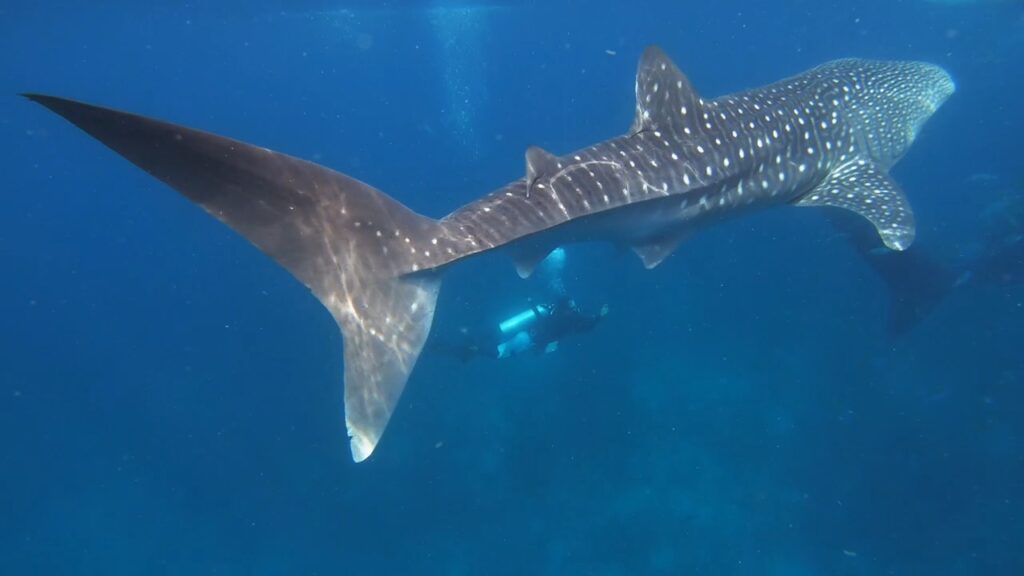
See Video Below
Exploring the Largest Fish: The Whale Shark
In the vast expanse of the world’s oceans, there exists a creature of immense size and gentle grace, captivating the imagination of scientists and nature enthusiasts alike—the whale shark (Rhincodon typus). This magnificent creature, often referred to as the gentle giant of the sea, holds numerous secrets within its massive frame. In this blog post, we embark on a journey to unravel the mysteries surrounding the largest fish in the ocean, exploring its biology, behavior, conservation status, and the crucial role it plays in marine ecosystems.
Anatomy and Physiology
Whale sharks are truly remarkable in size, with some individuals reaching lengths of over 40 feet (12 meters) and weighing as much as 20 metric tons. Despite their imposing stature, they are filter feeders, primarily consuming planktonic organisms such as krill, small fish, and microscopic plants. Their distinctive appearance, characterized by a broad, flattened head, and a wide mouth extending almost the full width of their body, serves a specialized purpose in filter feeding.
The skin of whale sharks is adorned with a unique pattern of pale stripes and spots, which is believed to be as unique to each individual as a fingerprint is to a human. This distinctive patterning has facilitated research into population dynamics and migration patterns.
Whale sharks are predominantly solitary creatures, roaming the world’s oceans in search of food and favorable environmental conditions. While they are known to undertake vast migrations spanning thousands of miles, their movements remain largely unknown, with much still to be understood about their migration routes and behavior.

Behavior and Ecology:
Whale sharks, the largest fish in the ocean, exhibit a diet predominantly consisting of plankton, but their nutritional intake also includes small fish, krill, fish eggs, and larvae. Utilizing ram filtration and active suction feeding mechanisms, whale sharks efficiently consume these minute organisms. In ram filtration, they swim with their mouths open, allowing water and prey to flow in, with food particles being trapped by gill rakers. Active suction feeding involves creating a vacuum to draw in dense prey patches.
One of the most remarkable aspects of whale shark behavior is their aggregations in certain areas during specific times of the year. These aggregations, or “hotspots,” often coincide with predictable events such as seasonal plankton blooms or the spawning of certain fish species. Locations such as Ningaloo Reef in Australia, the Gulf of Tadjoura in Djibouti, and the waters off the Yucatán Peninsula in Mexico are renowned for hosting large gatherings of whale sharks, providing unique opportunities for researchers and eco-tourists alike.
Understanding the feeding habits and ecological role of whale sharks is imperative for their conservation. As filter feeders, they are susceptible to threats like pollution, overfishing, and climate change. The establishment of marine protected areas and sustainable fishing practices are essential to mitigate these threats.

Conservation Status:
Despite their immense size and apparent abundance, whale sharks face numerous threats in today’s oceans. These threats include habitat degradation, bycatch in fisheries, ship strikes, and the increasingly pervasive impact of climate change. As a result, whale sharks are listed as “Endangered” on the International Union for Conservation of Nature (IUCN) Red List of Threatened Species.
In the vast and mysterious realm of the ocean, the whale shark stands as a symbol of both wonder and vulnerability. Its sheer size and graceful presence inspire awe, while its plight underscores the urgent need for conservation action. By continuing to study and protect these majestic creatures, we not only safeguard the biodiversity of our oceans but also preserve a vital component of marine ecosystems for future generations to cherish and admire.